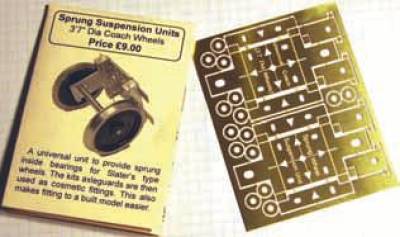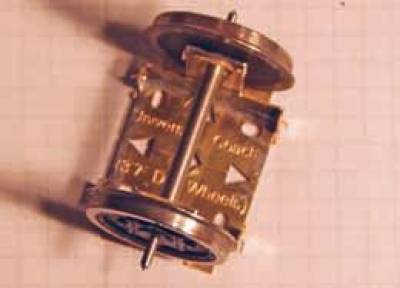Sprung Suspension Units for 3ft7in Coach Wheels
| Failed to open database: gaugegu1_gog2 | ret is false |
Reviewed by Bob Alderman
I was asked to review this item by Jim McGeown when I met him at the Reading Trade Show in December 2013. I have no need for the item and it was simply a request to report on assembling and using the item.
The units come as a pair on the fret with a comprehensive set of well-illustrated instructions. In addition to the fret two lengths of fine steel wire for the springs are provided.
They complement the coaches that are produced by Connoisseur but could be easily adapted for other vehicles. The etchings are particularly fine and sharp. Very small tags attach them into the body of the fret and they are easy to cut to release the parts. There is a main body; two sliding bearing units and set of washers to double the thickness to increase the bearing area. Varying the number of washers allows the units to be used for Finescale or Scaleseven. The main body has lines and holes etched in to assist alignment and securing.
I started the assembly by drilling out all the holes the wire is fitted in later. The first step is to fold up the sides and wire retaining tabs. The side has to be partially bent before the tabs can be bent around as access to them is easier at this point. I noticed that when bending the side there was tendency for the centre line mark to bend as well. This has to be avoided and the base maintained flat. As is usual the half etched fold lines are filled with solder to stiffen them.
Once both sides are bent, doublers are folded through 180° on long half etch tabs and soldered to the base to stiffen it. It may be better to bend and solder these to stiffen and support the base before bending the sides to prevent the base distorting. The sliding bearing parts have three tabs to bend through 90°. The half etch lines of the folds have to be filled with solder to stiffen them. As these provide the location and guidance for the parts on the base, only sufficient solder to fill the corner should be applied. Too large a fillet will restrict the motion.
The appropriate washers for the bearing were added next. I found that here a generous amount of solder is needed to attached them. There should be enough for the washer to float on the molten solder. Apply the iron beside the washer to allow it to move on the solder; the surface tension will centre it over the hole in the slider. I fitted the second washer on the inside of the slider. Looking back at the instructions it is not clear if I should have done this or stacked the pair. Nevertheless when assembled the unit worked. At this stage the three separate components were cleaned.
To ensure the parts move freely, the edges of the main legs benefit from a polish with a fine abrasive block. Similarly the edges of the inside washer were polished to ensure the edges did not grab. The axle holes need to be opened up to accept the axle. As the instructions advise use a broach; take it bit by bit from alternating the cut from one side to the other. Check that the hole is not made oversize by trying the axle at every stage. Final assembly is to fit the wheel set and the spring wire. A wheel has to be removed from the axle and the two sliding parts and body threaded onto the axle and the wheel replaced. Before threading the wire I bent one end through 90° by about 3mm long to retain that end before cutting and bending the other to complete the retention. This operation is slightly hazardous as the snipped ends are very sharp. I blunted them with a cutting disc.
A pair of quality side cutters are needed to cut the wire as it is hard. I would suggest that using a cutting disc to cut the wire is inadvisable.
The completed unit moved freely up and down and the wheel revolved with only one side deflected. With the wire supplied it would appear that the weight of the vehicle will fully deflect the assembly only allowing the wheels to move downwards to fill a hollow in the track. The instructions suggest that alternative thicker wire, sourced from guitar strings, can be used to change the weight /deflection of the assembly. If thicker wire is used I think that the spring could become weight bearing allowing both up and down movement about a mean position.
The unit is simple and works well and could be adapted to many applications. It is a useful addition to the range of components available for making underframes. There is also a similar set for a six wheel vehicle; the centre unit being narrower to allow greater sideplay in that wheelset.









